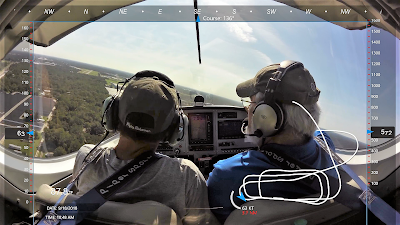Hurricane Florence was finally dissipating in North Carolina and there were no ill effects in central Florida. It should be a good day to go flying. I asked Alexa about the forecast and the typical response came back with 30% chance of thunderstorms. But the next line got my attention; A high of 93°s. I sat down at my office computer to start my weather briefing. Soon I got a text message from my student. We were good to go.
 I met my student at the FBO and drove over to the hangar. I was just after 9:00AM and the Florida temperature was already in the high 80°s. I had done some work on Sally the previous day and left the top cowling off. We reviewed the major parts of the engine and went over the normal preflight engine checks. He burped the engine then buttoned her up. Next, he climbed into the cockpit and pulled the checklist from the side pocket and went through each of the items. As we went through the checklist I pointed out special focus items, answered questions and helped him do a thorough walk-around. (I also learned how to make some changes on the checklist to make it more efficient.) It took about 45 minutes. As he pulled Sally out of the hangar, I went back to the truck to drive it into the hangar.
I met my student at the FBO and drove over to the hangar. I was just after 9:00AM and the Florida temperature was already in the high 80°s. I had done some work on Sally the previous day and left the top cowling off. We reviewed the major parts of the engine and went over the normal preflight engine checks. He burped the engine then buttoned her up. Next, he climbed into the cockpit and pulled the checklist from the side pocket and went through each of the items. As we went through the checklist I pointed out special focus items, answered questions and helped him do a thorough walk-around. (I also learned how to make some changes on the checklist to make it more efficient.) It took about 45 minutes. As he pulled Sally out of the hangar, I went back to the truck to drive it into the hangar. We buckled in and completed the Start Checklist. Sally started quickly and smoothly. OAT read 31°s (88°F). Cylinder Head Temperature(CHT) read 220°F. Winds were calm, less than 5kts out of the south, but prevailing traffic was using RWY5. A long taxi for us. When we got to the runup area CHT was up to 240°s. I had already told the student to use the run-up checklist as memory items. In other words, not hesitate with each step but smoothly go from one to the next. By the time he finished his takeoff brief at the hold short line, the CHT was climbing past 250°. A CAP plane was on base turning on final. I asked the student to hold short but add power to 2500-3000 RPM to help cool the cylinder heads. Dropped back to 248°s. When the CAP airplane finally cleared were we back above 250°s. My No Go is 260°s. After the successful take off he chose a "cruise climb" at 70kts. It was 250°s passing 700'. We leveled at 1500' and the temp dropped back to normal.
We buckled in and completed the Start Checklist. Sally started quickly and smoothly. OAT read 31°s (88°F). Cylinder Head Temperature(CHT) read 220°F. Winds were calm, less than 5kts out of the south, but prevailing traffic was using RWY5. A long taxi for us. When we got to the runup area CHT was up to 240°s. I had already told the student to use the run-up checklist as memory items. In other words, not hesitate with each step but smoothly go from one to the next. By the time he finished his takeoff brief at the hold short line, the CHT was climbing past 250°. A CAP plane was on base turning on final. I asked the student to hold short but add power to 2500-3000 RPM to help cool the cylinder heads. Dropped back to 248°s. When the CAP airplane finally cleared were we back above 250°s. My No Go is 260°s. After the successful take off he chose a "cruise climb" at 70kts. It was 250°s passing 700'. We leveled at 1500' and the temp dropped back to normal.I wanted to get 5 landings in today. We did three at Plant City and would have done another but it just getting too crowded. I decided to try some more back at Tampa Executive. Although not as bad, there were two in the pattern...and it was hot. We ended the flight with a great landing and taxied back to the FBO. It was hot. OAT read 34°C. (93°F)
The weatherman on the radio said the "feel like" temperature was 101°s. Time to call it a day.




